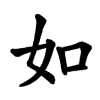Definify.com
Definition 2025
八
八
| ||||||
|---|---|---|---|---|---|---|
Translingual
| Stroke order | |||
|---|---|---|---|

| |||
Han character
八 (radical 12 八+0, 2 strokes, cangjie input 竹人 (HO), four-corner 80000, composition ⿹丿乁)
- Kangxi radical #12, ⼋ (“eight”).
Usage notes
Minor strokes in the shape of ハ/八, as in the top of 劵, can be referred to 八. These are very frequently simplified to 丷. Contrast 劵/券, and different forms of 鬲/鬲.
Derived characters
- Index:Chinese radical/八
- 䒔
Descendants
- Japanese: ハ (ha)
References
- KangXi: page 126, character 26
- Dai Kanwa Jiten: character 1450
- Dae Jaweon: page 274, character 13
- Hanyu Da Zidian: volume 1, page 241, character 3
- Unihan data for U+516B
Chinese
Glyph origin
| Historical forms of the character 八
| |||||||||||||||||||||||||||||||||||||||
|---|---|---|---|---|---|---|---|---|---|---|---|---|---|---|---|---|---|---|---|---|---|---|---|---|---|---|---|---|---|---|---|---|---|---|---|---|---|---|---|
| Oracle bone script | Bronze inscriptions | Bamboo and silk script | Large seal script | Small seal script | |||||||||||||||||||||||||||||||||||
 |
 |
 |
 |
 |
|||||||||||||||||||||||||||||||||||
| |||||||||||||||||||||||||||||||||||||||
|
References:
Mostly from Richard Sears' Chinese Etymology site (authorisation),
| |||||||||||||||||||||||||||||||||||||||
| Characters in the same phonetic series (八) (Zhengzhang, 2003) | |
|---|---|
| Old Chinese | |
| 扒 | *preːds, *preːd, *pred |
| 八 | *preːd |
| 𩡩 | *preːd |
| 朳 | *preːd |
| 玐 | *preːd |
| 釟 | *preːd |
| 汃 | *pʰreːd, *prɯn |
Ideogrammic compound (會意) : 八 is two bent lines indicating the original meaning of "to divide". This character is later borrowed to mean "eight" because of homonymy, making the original meaning obsolete (now represented by 別).
Etymology 1
|
simp. and trad. |
八 | |
|---|---|---|
| alt. forms | 捌 financial | |
From Proto-Sino-Tibetan *b-r-gjat (“eight”). Compare Tibetan བརྒྱད (brgyad).
Pronunciation
- Mandarin
- Cantonese (Jyutping): baat3
- Hakka (Sixian, PFS): pat
- Min Dong (BUC): báik
- Min Nan
- Wu (Wiktionary): paq (T4)
- Mandarin
- (Standard Chinese, Beijing)+
- Pinyin:
- Zhuyin: ㄅㄚ
- Wade-Giles: pa1
- Gwoyeu Romatzyh: ba
- IPA (key): /pa̠⁵⁵/
-

- Note: bá - a less common tone sandhi variant of 八 when it occurs before a departing-tone character, e.g. 八路.
- (Standard Chinese, Beijing)+
- Cantonese
- (Standard Cantonese, Guangzhou)+
- Jyutping: baat3
- Yale: baat
- Cantonese Pinyin: baat8
- IPA (key): /pɑːt̚³/
- (Standard Cantonese, Guangzhou)+
- Hakka
- (Sixian, incl. Miaoli and Meinong)
- Pha̍k-fa-sṳ: pat
- Hakka Romanization System: bad`
- Hagfa Pinyim: bad5
- IPA: /pat̚²/
- (Sixian, incl. Miaoli and Meinong)
- Min Dong
- (Fuzhou)
- Bàng-uâ-cê: báik
- IPA (key): /paiʔ²⁴/
- (Fuzhou)
- Min Nan
- (Hokkien: Zhangzhou, Kaohsiung, Tainan, Taichung, Yilan)
- Pe̍h-ōe-jī: peh
- Tâi-lô: peh
- Phofsit Daibuun: peq
- IPA (Zhangzhou): /peʔ³²/
- IPA (Kaohsiung): /peʔ³²/
- (Hokkien: Xiamen, Quanzhou, Taipei, Lukang, Sanxia, Kinmen, Magong, Hsinchu)
- Pe̍h-ōe-jī: poeh
- Tâi-lô: pueh
- Phofsit Daibuun: poeq
- IPA (Xiamen): /pueʔ³²/
- IPA (Quanzhou): /pueʔ⁵/
- IPA (Taipei): /pueʔ³²/
- (Hokkien: Xiamen, Quanzhou, Zhangzhou, mainstream Taiwanese)
- Pe̍h-ōe-jī: pat
- Tâi-lô: pat
- Phofsit Daibuun: pad
- IPA (Xiamen): /pat̚³²/
- IPA (Quanzhou): /pat̚⁵/
- IPA (Zhangzhou): /pat̚³²/
- IPA (Taipei): /pat̚³²/
- IPA (Kaohsiung): /pat̚³²/
- Note: peh/poeh - vernacular; pat - literary.
- (Teochew)
- Peng'im: boih4
- Pe̍h-ōe-jī-like: poih
- IPA (key): /poiʔ²/
- (Hokkien: Zhangzhou, Kaohsiung, Tainan, Taichung, Yilan)
- Wu
- (Shanghainese)
- Wiktionary: paq (T4)
- IPA (key): /pᴀʔ⁵⁵/
- (Shanghainese)
| Rime | |
|---|---|
| Character | 八 |
| Reading # | 1/1 |
| Initial (聲) | 幫 (1) |
| Final (韻) | 鎋 (75) |
| Tone (調) | Checked (Ø) |
| Openness (開合) | Open |
| Division (等) | II |
| Fanqie | 博拔切 |
| Reconstructions | |
| Zhengzhang Shangfang |
/pˠɛt̚/ |
| Pan Wuyun |
/pᵚæt̚/ |
| Shao Rongfen |
/pæt̚/ |
| Edwin Pulleyblank |
/pəɨt̚/ |
| Li Rong |
/pɛt̚/ |
| Wang Li |
/pæt̚/ |
| Bernard Karlgren |
/pat̚/ |
| Expected Mandarin Reflex |
ba |
| Baxter-Sagart system 1.1 (2014) | |
|---|---|
| Character | 八 |
| Reading # | 1/1 |
| Modern Beijing (Pinyin) |
bā |
| Middle Chinese |
‹ pɛt › |
| Old Chinese |
/*pˤret/ |
| English | eight |
Notes for Old Chinese notations in the Baxter-Sagart system: * Parentheses "()" indicate uncertain presence; | |
| Zhengzhang system (2003) | |
|---|---|
| Character | 八 |
| Reading # | 1/1 |
| No. | 89 |
| Phonetic component |
八 |
| Rime group |
月 |
| Rime subdivision |
2 |
| Corresponding MC rime |
八 |
| Old Chinese |
/*preːd/ |
Definitions
八
- eight
- many, numerous
- (printing) pearl; The smallest size of usual type, standardized as 5 point.
- Short for 八卦 (bāguà).
- A surname.
See also
| Chinese numbers | ||||||||||||||||
|---|---|---|---|---|---|---|---|---|---|---|---|---|---|---|---|---|
| 0 | 1 | 2 | 3 | 4 | 5 | 6 | 7 | 8 | 9 | 10 | 102 | 103 | 104 | 108 | 1012 | |
| Cardinal | 〇 | 一 | 二 | 三 | 四 | 五 | 六 | 七 | 八 | 九 | 十 | 百 | 千 | 萬 万 |
億 亿 |
兆 |
| Financial | 零 | 壹 | 貳 贰 |
參 叁 |
肆 | 伍 | 陸 陆 |
柒 | 捌 | 玖 | 拾 | 佰 | 仟 | 萬 万 |
億 亿 |
兆 |
Compounds
|
|
Descendants
Others:
Etymology 2
|
simp. and trad. |
八 | |
|---|---|---|
From Proto-Sino-Tibetan *brat (“cut apart, cut open”). Cognate to 別/别 (bié).
Pronunciation
- Mandarin
- (Standard Chinese, Beijing)+
- Pinyin:
- Zhuyin: ㄅㄚ
- Wade-Giles: pa1
- Gwoyeu Romatzyh: ba
- IPA (key): /pa̠⁵⁵/
- (Standard Chinese, Beijing)+
| Rime | |
|---|---|
| Character | 八 |
| Reading # | 1/1 |
| Initial (聲) | 幫 (1) |
| Final (韻) | 鎋 (75) |
| Tone (調) | Checked (Ø) |
| Openness (開合) | Open |
| Division (等) | II |
| Fanqie | 博拔切 |
| Reconstructions | |
| Zhengzhang Shangfang |
/pˠɛt̚/ |
| Pan Wuyun |
/pᵚæt̚/ |
| Shao Rongfen |
/pæt̚/ |
| Edwin Pulleyblank |
/pəɨt̚/ |
| Li Rong |
/pɛt̚/ |
| Wang Li |
/pæt̚/ |
| Bernard Karlgren |
/pat̚/ |
| Expected Mandarin Reflex |
ba |
| Baxter-Sagart system 1.1 (2014) | |
|---|---|
| Character | 八 |
| Reading # | 1/1 |
| Modern Beijing (Pinyin) |
bā |
| Middle Chinese |
‹ pɛt › |
| Old Chinese |
/*pˤret/ |
| English | eight |
Notes for Old Chinese notations in the Baxter-Sagart system: * Parentheses "()" indicate uncertain presence; | |
| Zhengzhang system (2003) | |
|---|---|
| Character | 八 |
| Reading # | 1/1 |
| No. | 89 |
| Phonetic component |
八 |
| Rime group |
月 |
| Rime subdivision |
2 |
| Corresponding MC rime |
八 |
| Old Chinese |
/*preːd/ |
Definitions
八
- † to divide; to differentiate
Etymology 3
| For pronunciation and definitions of 八 – see 捌 (“to know”). (This character, 八, is a variant form of 捌.) |
Japanese
Etymology 1
Pronunciation
Numeral
| < 7 | 8 | 9 > |
|---|---|---|
| Cardinal : 八 | ||
八 (hiragana はち, romaji hachi)
Noun
八 (hiragana はち, romaji hachi)
Etymology 2
The ablaut form of 四 (yo, “four”), which it doubles.
Noun
Related terms
- 八つ
- 嘘っ八
- 一か八か
Kanji
Readings
- Goon: はち (hachi)
- Kan’on: はつ (hatsu)
- Kun: や (ya), やつ (八つ, yatsu), やっつ (八つ, yattsu), よう (yō)
- Nanori: な (na), は (ha), はっ (ha' ), はつ (hatsu), やち (yachi), やつ (yatsu)
Compounds
Korean
Hanja
八 • (pal, bae)
Eumhun:
- Name (hangeul): 여덟 (revised: yeodeolp, McCune-Reischauer: yŏdŏl, Yale: yetelp)
Numeral
八 • (pal) (hangeul 팔)
- (cardinal) eight
Vietnamese
Han character
- This term needs a translation to English. Please help out and add a translation, then remove the text
{{rfdef}}.


































